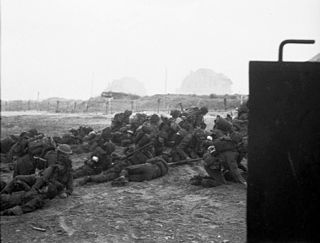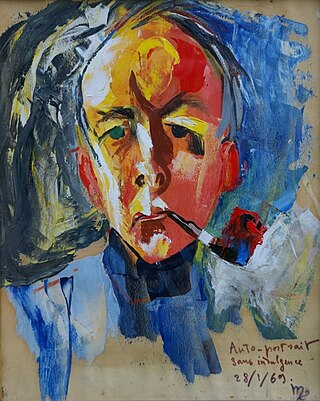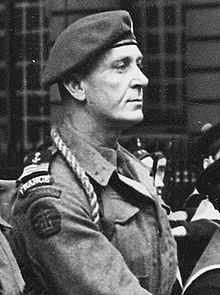
A paratrooper is a military parachutist—someone trained to parachute into a military operation, and usually functioning as part of an airborne force. Military parachutists (troops) and parachutes were first used on a large scale during World War II for troop distribution and transportation. Paratroopers are often used in surprise attacks, to seize strategic objectives such as airfields or bridges.

Sword, commonly known as Sword Beach, was the code name given to one of the five main landing areas along the Normandy coast during the initial assault phase, Operation Neptune, of Operation Overlord. The Allied invasion of German-occupied France commenced on 6 June 1944. Stretching 8 kilometres (5.0 mi) from Ouistreham to Saint-Aubin-sur-Mer, the beach proved to be the easternmost landing site of the invasion after the abortion of an attack on a sixth beach, code-named Band. Taking Sword was to be the responsibility of the British Army with sea transport, mine sweeping and a naval bombardment force provided by the British Royal Navy as well as elements from the Polish, Norwegian and other Allied navies.

The Commandos, also known as the British Commandos, were formed during the Second World War in June 1940, following a request from Winston Churchill, for special forces that could carry out raids against German-occupied Europe. Initially drawn from within the British Army from soldiers who volunteered for the Special Service Brigade, the Commandos' ranks would eventually be filled by members of all branches of the British Armed Forces and a number of foreign volunteers from German-occupied countries. By the end of the war 25,000 men had passed through the Commando course at Achnacarry. This total includes not only the British volunteers, but volunteers from Greece, France, Belgium, Netherlands, Canada, Norway, Poland, and the United States Army Rangers and US Marine Corps Raiders, which were modelled on the Commandos.

The Commandos Marine are the special operation forces (SOF) of the French Navy. The Commandos Marine are nicknamed Bérets Verts. They operate under the Sailor Riflemen and Special Operations Forces Command (FORFUSCO) and form part of the French Special Operations Command.

Philippe Kieffer, capitaine de frégate in the French Navy, was a French officer and political personality, and a hero of the Free French Forces.

FORFUSCO is a syllabic abbreviation for the Force maritime des fusiliers marins et commandos, headquartered in Lorient, is the French Navy organisation responsible for and in command of the Fusiliers Marins and Commandos Marine. FORCUSCO is headed by a general officer with the title of Admiral commandant Les fusiliers marins et commandos (ALFUSCO).

The Fusiliers marins are specialized French security force trained for combat on land and coastal regions. The Fusiliers marins are in charge of providing protection for naval vessels and key French Navy sites on land.

The 1er Régiment de Parachutistes d'Infanterie de Marine or 1er RPIMa is a unit of the French Army Special Forces Command, therefore part of the Special Operations Command.

The 6th Marine Infantry Parachute Regiment is an airborne infantry unit of the French Army.

Guy Joseph Marie de Villardi comte de Montlaur was a French painter from the Languedoc family of Montlaur.
41 Commando or No. 41 Commando was a unit of the Royal Marines trained as Commandos during the Second World War. They were part of the all Royal Marine 4th Special Service Brigade that took part in the Normandy landings in June 1944 and later that served in World War II, the Korean War, and in Northern Ireland. They were disbanded in 1981.

No. 10 (Inter-Allied) Commando was a commando unit of the British Army during the Second World War, recruited largely from non-British personnel from German-occupied Europe. This unit was used to help co-ordinate attacks with other allied forces.
No. 44 Commando was a battalion size formation in the British Commandos, formed during the Second World War. The Commando was assigned to the 3rd Special Service Brigade and served in the Burma Campaign.
No. 48 Commando was a battalion-sized formation of the British Commandos, formed in 1944 during the Second World War. No. 48 Commando was assigned to the 4th Special Service Brigade and served in North West Europe, taking part in the Normandy landings and operations around Ostend and Antwerp before being disbanded after the war in January 1946.

The 3rd Parachute Chasseur Regiment or 3e RCP was a French unit of Second World War known in the British Army as the 3rd SAS Regiment and originally named the 3rd Air Infantry Battalion. Involved in the operations of the Liberation of France and The Netherlands, the unit was temporarily dissolved at the end of the conflict and was reorganized between 1979 and 1998.

The 2nd Parachute Chasseur Regiment or 2e RCP, is one of the most decorated French units of the Second World War, the only land unit awarded the red fourragère in that war, including six citations at the orders of the armed forces. The French Navy 1500-ton class submarine Casabianca also accumulated six citations at the orders of the armed forces and therefore its crewmen were entitled to wear the same fourragère.

The 1er Régiment de Fusiliers Marins 1er RFM French was a unit of the Free French Navy during the campaign of Italy, then in the campaign of France.

The Régiment Blindé de Fusiliers-Marins or (RBFM) was an armored naval infantry regiment of the French 2nd Armored Division. The regiment belonged to the units of the French Fusiliers Marins, which are units of the French Navy whose ships were either immobilized or destroyed.

The French Liberation Army was the reunified French Army that arose from the merging of the Armée d'Afrique with the prior Free French Forces during World War II. The military force of Free France, it participated in the Italian and Tunisian campaigns before joining in the Liberation of France with other Western Allies of World War II. It went on to join the Western Allied invasion of Germany.


















